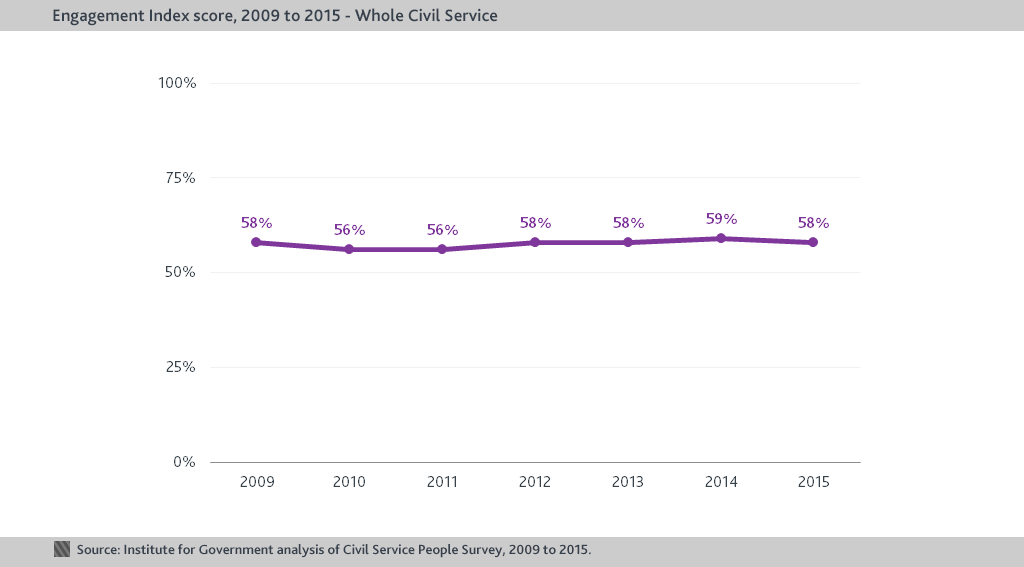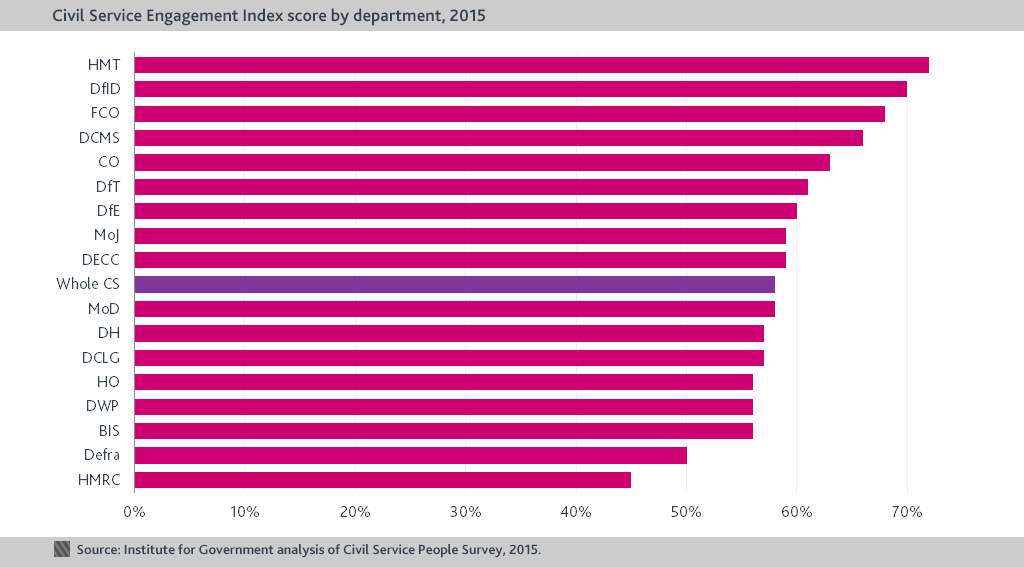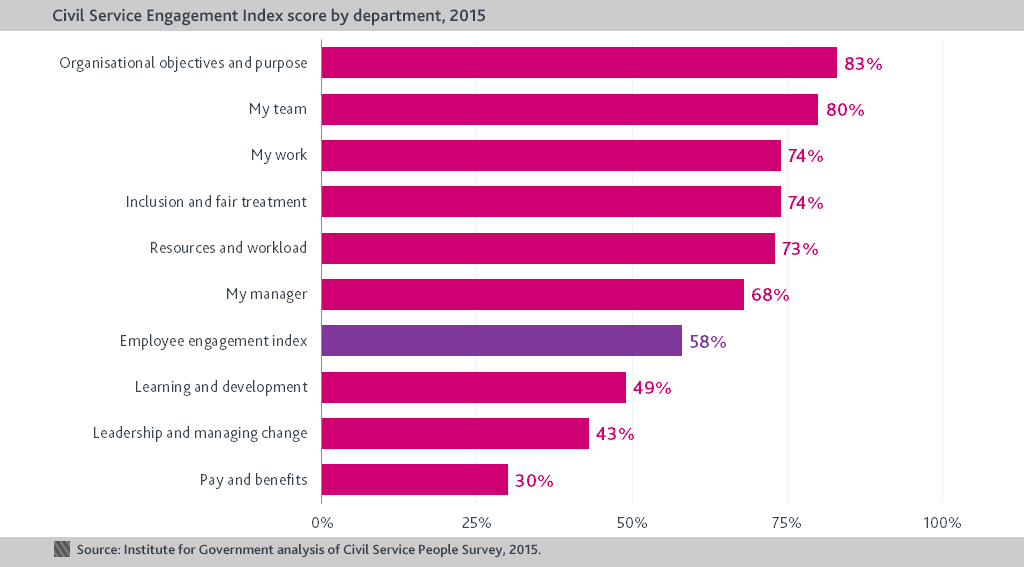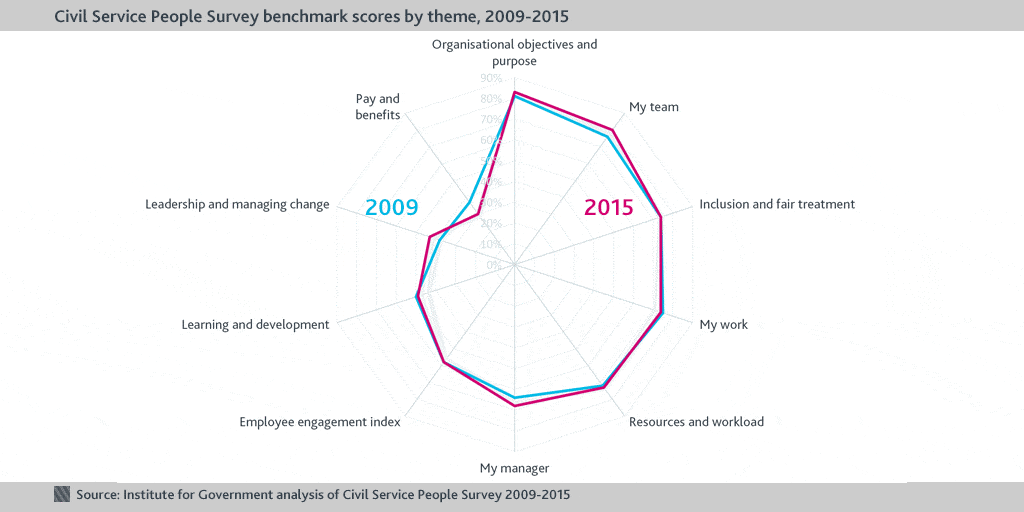The results of the Civil Service People Survey 2015, the UK’s largest employee attitude survey, have just been published. Ollie Hirst and Gavin Freeguard look at the top-level results and find the Civil Service in fairly good spirits, but unhappy about their pay.
The 2015 Civil Service People Survey was conducted across 96 government organisations from 1 to 31 October, with 279,653 employees participating, representing an overall response rate of 65%. The Survey consists of 62 questions across ten themes, including what civil servants think of their team, their manager, pay and benefits, and leadership and managing change within their organisation. One of the ten themes is the ‘Engagement Index’, a weighted average of five questions:
- whether civil servants are proud when they tell others they are part of their organisation
- whether they would recommend it as a great place to work
- whether they feel a strong personal attachment to it
- whether it inspires them to do the best in their job
- whether it motivates them to help it achieve its objectives.
Civil Service engagement is down by one percentage point in 2015, but has remained broadly constant since 2009. 


- While HMRC has been the lowest-scoring department since 2009, it has risen from a low of 34% in 2010 to a high of 45% in 2015. At the other end of the spectrum, DfID, FCO and HMT have had the top three engagement scores every year since the People Survey started.
- DfE’s score fell every year from 2009 to 2013 – from 63% to 51% – before jumping nine points between 2013 and 2015 to 60%. Inevitably, some have linked the change of Secretary of State and special advisers with the rise, but previous Institute for Government research suggests that the completion of a redundancy process that staff felt ‘was unfair and had negatively impacted on morale’ may also explain it.
- Engagement in DCMS fell from 54% in 2011 to 45% in 2012. The 2012 survey was conducted shortly after the London Olympics and Paralympics, and just as all non-Senior Civil Service staff were at risk of redundancy. Its current score of 66% is ten points higher than its 56% score in 2009.
- DCLG’s decreasing score (from 48% in 2010 to 40% in 2011) also coincided with staff reductions, although its current score of 57% is an overall increase from 53% in 2009.
- In all, nine departments have higher engagement scores in 2015 than in 2009 (HMT, DCMS, CO, DfT, MoJ, DCLG, BIS, DWP, HMRC); while eight have lower scores (DfID, FCO, DfE, DECC, MoD, DH, HO, Defra). Defra has experienced the biggest fall (five points), followed by DECC and HO (four).
With further staff reductions likely following the Spending Review, those in charge of departments may have to manage through a similar pattern of dips in engagement during the next five years. Organisational objectives and purpose is the theme with the highest score, while civil servants are least satisfied with their pay and benefits.


- ‘Organisational objectives and purpose’ to 83%
- ‘My team’ to 80%
- ‘Inclusion and fair treatment’ to 74%
- ‘Resources and workload’ to 73%
- ‘My manager’ to 68%.
Two themes fell over the course of the Coalition Government, but have now recovered:
- ‘Learning and development’ fell from 50% in 2009 to 43% in 2010, before recovering to 49% in 2014 and 2015.
- ‘My work’ fell from 75% in 2009 to 71% in 2010, but has risen back to 74%.
Two theme scores have changed significantly since 2009:
- ‘Pay and benefits’ was already the lowest-scoring theme in 2009 (37%) but fell by nine percentage points, to 28% in 2014. Although this has risen to 30% in 2015, it remains the lowest-scoring theme.
- ‘Leadership and managing change’ – how well the organisation is managed and change within it led – has risen from 38% in 2009 to 43% in 2015.
On the whole, then, civil servants are largely positive about their work and those they work with, the purpose of their organisation and – perhaps surprisingly – their workload, despite the reductions in budgets and staff numbers (although of course it might be the case that civil servants who have left in the last five years had more negative views than the ones who stayed). But even though civil servants have become less negative about how change in their departments is led, fewer than half of those surveyed in 2015 were actually positive about it. Pay and benefits remain a source of unhappiness – departmental leaders will need to find other ways to motivate their employees as pay restraint continues over the course of this parliament.
Details of the survey can be found here. The numbers used in this blog update those in Whitehall Monitor 2015: The Coalition in 163 Charts, published by the Institute for Government on 19 November. Abbreviations for government departments can be found here.
- Topic
- Civil service
- Tracker
- Whitehall Monitor
- Publisher
- Institute for Government